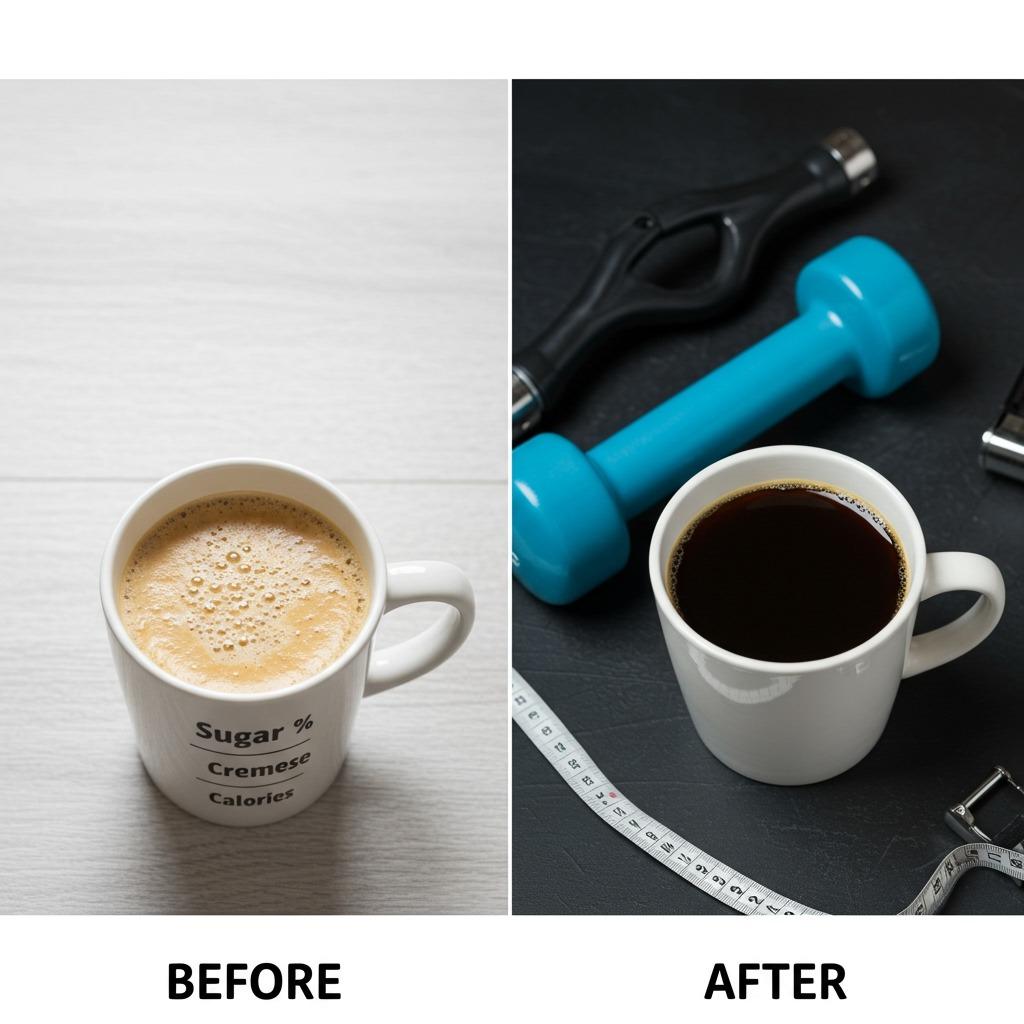Last month, my fitness-focused friend Sarah excitedly told me about her “coffee trick” that helped her drop 8 pounds in six weeks. She claimed that drinking coffee in a specific way before her workouts was transforming her metabolism and appetite. Naturally skeptical, I started researching the science behind coffee and weight loss, and what I discovered surprised me.
Coffee does indeed offer several legitimate mechanisms that can support weight loss efforts when used strategically. However, the reality is more nuanced than social media “tricks” suggest, and understanding the science helps separate effective approaches from marketing hype. The key lies in leveraging coffee’s natural properties while avoiding the pitfalls that can sabotage your weight loss goals.

The Science Behind Coffee and Weight Loss
Coffee contains several compounds that can influence weight management through different biological pathways. Caffeine, the most well-known component, acts as a natural stimulant that can increase metabolic rate by 3-11%, with higher effects in lean individuals compared to obese individuals.
Chlorogenic acid, found in higher concentrations in green coffee beans, may help reduce carbohydrate absorption and improve fat metabolism. This compound partially survives the roasting process, meaning regular coffee still contains beneficial amounts.
Theobromine and theophylline, other natural compounds in coffee, work synergistically with caffeine to enhance fat oxidation and provide sustained energy without the crash associated with simple stimulants.
The thermogenic effect of coffee means your body burns more calories digesting and metabolizing it compared to other beverages. This effect, combined with appetite suppression, creates conditions that can support weight loss when part of an overall healthy approach.
Research published in the American Journal of Clinical Nutrition shows that caffeine can increase fat oxidation by up to 29% in lean individuals and 10% in obese individuals, suggesting coffee’s effectiveness varies based on individual metabolism and body composition.
Popular Coffee Weight Loss “Tricks” Explained
The Morning Black Coffee Method
The most commonly cited coffee trick involves drinking black coffee first thing in the morning, 30-60 minutes before exercise. This approach leverages caffeine’s ability to mobilize fatty acids from fat tissues, making them available as fuel during physical activity.
How it works: Caffeine stimulates the nervous system, sending signals to fat cells to break down fat and release it into the bloodstream as free fatty acids. When combined with exercise, these fatty acids are burned for energy instead of being stored.
The timing matters because drinking coffee on an empty stomach maximizes absorption and minimizes interference from food. The 30-60 minute window allows caffeine levels to peak just as you begin exercising, optimizing fat-burning potential.
The Coffee and Lemon Combination
This trending method involves adding fresh lemon juice to black coffee, claiming enhanced weight loss benefits through improved metabolism and detoxification.
The reality: While lemon adds vitamin C and may provide slight digestive benefits, there’s no scientific evidence that lemon significantly enhances coffee’s weight loss properties. The primary benefits still come from the coffee itself, not the lemon addition.
However, lemon can make black coffee more palatable for people who struggle with the bitter taste, potentially helping them avoid adding sugar or cream that would increase caloric content.

Intermittent Fasting with Coffee
Many intermittent fasting practitioners use black coffee during fasting windows to suppress appetite and maintain energy levels without breaking their fast.
The mechanism: Coffee helps reduce hunger hormones like ghrelin while increasing satiety hormones, making it easier to extend fasting periods. The caffeine also helps maintain mental alertness during periods of reduced caloric intake.
Important considerations: Adding any calories to coffee (milk, sugar, cream) can break a fast and reduce the metabolic benefits associated with fasting states.
The Coffee Loophole Method
The “coffee loophole” refers to a specific approach that involves drinking coffee strategically to enhance fat burning while avoiding common mistakes that can sabotage weight loss efforts.
Core principles include:
- Drinking black coffee or coffee with minimal calories
- Timing consumption to maximize metabolic benefits
- Using coffee to enhance workout performance
- Avoiding additions that spike insulin or add significant calories
This method focuses on leveraging coffee’s natural appetite suppressant and metabolism-boosting properties while maintaining the caloric deficit necessary for weight loss. For more detailed information about this approach, you can explore the coffee loophole for comprehensive guidance.
Optimal Timing for Weight Loss Benefits
Pre-workout consumption (30-45 minutes before exercise) maximizes fat oxidation during physical activity. Research shows this timing can increase fat burning by up to 15% during moderate-intensity exercise.
Morning consumption on an empty stomach enhances absorption and provides sustained energy throughout the day. This timing also helps suppress appetite during peak hunger hours.
Avoiding late-day coffee prevents sleep disruption, which is crucial for weight management. Poor sleep affects hunger hormones and metabolism, potentially counteracting coffee’s benefits.
Spacing throughout the day rather than consuming large amounts at once helps maintain steady energy levels and sustained appetite suppression without causing jitters or crashes.
What to Add (and Avoid) in Weight Loss Coffee
Beneficial additions:
- Cinnamon: Helps regulate blood sugar and may improve insulin sensitivity
- MCT oil: Provides quick energy and may enhance fat burning, though it adds calories
- Unsweetened cocoa powder: Adds antioxidants and flavor with minimal calories
- A small amount of coconut oil can provide sustained energy for longer workouts
Additions to avoid:
- Sugar and artificial sweeteners: Can spike insulin and potentially increase cravings
- High-calorie creamers: Add significant calories that can offset weight loss benefits
- Flavored syrups: Often contain hidden sugars and artificial ingredients
- Whipped cream or heavy additions: Transform coffee from a weight loss tool into a high-calorie treat
The key is keeping additions minimal to preserve coffee’s natural benefits while making it palatable enough to consume consistently.

Coffee Types That Support Weight Loss
Black coffee remains the gold standard for weight loss, providing maximum benefits with zero calories. All coffee varieties offer similar caffeine content, so choose based on taste preferences.
Cold brew offers a smoother, less acidic option that many find easier to drink black. The brewing method doesn’t significantly affect weight loss properties, but the reduced bitterness may help people avoid adding sweeteners. For those interested in this option, learning about the difference between cold brew and iced coffee can help you choose the best preparation method.
Green coffee extract contains higher levels of chlorogenic acid, which some studies suggest may enhance weight loss. However, the effects are modest, and regular coffee still provides significant benefits.
Espresso offers concentrated caffeine in smaller volumes, making it ideal for people who want coffee’s benefits without consuming large amounts of liquid before workouts.
Exercise and Coffee Synergy
Combining coffee with cardio creates optimal conditions for fat burning. The caffeine mobilizes fatty acids while cardiovascular exercise burns them for fuel, creating a synergistic effect.
Pre-strength training coffee can improve workout intensity and duration, leading to greater caloric expenditure both during and after exercise through increased muscle building and recovery demands.
High-intensity interval training (HIIT) paired with pre-workout coffee consumption may maximize fat oxidation during both the workout and recovery periods.
Endurance activities benefit from coffee’s ability to spare glycogen stores by promoting fat utilization, potentially improving performance and body composition simultaneously.
Potential Side Effects and Precautions
Caffeine sensitivity varies significantly between individuals. Start with smaller amounts to assess tolerance, and be aware that weight loss benefits plateau as tolerance develops.
Sleep disruption can occur if coffee is consumed too late in the day. Poor sleep negatively affects hormones that regulate hunger and metabolism, potentially counteracting weight loss efforts.
Increased anxiety or jitters in sensitive individuals can lead to stress eating or poor food choices. Monitor your response and reduce intake if negative effects occur.
Digestive issues may develop from drinking coffee on an empty stomach. If this occurs, try consuming a small amount of food with your coffee or reducing the amount consumed.
Dependency concerns should be considered with regular high caffeine intake. Cycling off coffee periodically may help maintain its effectiveness and prevent tolerance buildup.
Creating a Sustainable Coffee Weight Loss Plan
Consistency matters more than perfection. Establish a routine that fits your lifestyle and can be maintained long-term rather than following extreme approaches that aren’t sustainable.
Monitor your total caloric intake because coffee alone won’t create weight loss if you’re consuming excess calories from other sources. Coffee should support, not replace, healthy eating habits.
Track your response to different timing, amounts, and preparations to find what works best for your body and schedule. Individual responses to caffeine vary significantly.
Combine with other healthy habits like regular exercise, adequate sleep, and balanced nutrition for optimal results. Coffee is a tool, not a complete weight loss solution.
For those interested in exploring other coffee preparation methods that support healthy lifestyles, understanding how to make French press coffee provides options that maintain beneficial compounds while offering variety in preparation.

Common Mistakes That Sabotage Coffee Weight Loss
Adding too many calories through cream, sugar, or flavored additions can turn coffee from a weight-loss aid into a calorie-dense beverage that hinders progress.
Drinking coffee too late disrupts sleep quality, which affects hormones that regulate appetite and metabolism. Poor sleep can completely negate coffee’s metabolic benefits.
Relying solely on coffee without addressing overall diet and exercise habits limits potential results. Coffee enhances other healthy behaviors, but can’t overcome poor lifestyle choices.
Consuming excessive amounts can lead to tolerance, anxiety, and other side effects that may actually impair weight loss efforts through increased stress and poor decision-making.
Expecting immediate results leads to disappointment and abandonment of the approach. Coffee’s weight loss benefits are modest and work best as part of a comprehensive plan.
The Reality Check: What Coffee Can and Can’t Do
Coffee can genuinely support weight loss through several mechanisms: increased metabolism, appetite suppression, enhanced fat oxidation during exercise, and improved workout performance. These effects are real and measurable, though modest.
However, coffee isn’t a magic weight loss solution. It won’t overcome poor dietary choices, lack of exercise, or other lifestyle factors that influence weight. The benefits are supportive rather than transformative.
Realistic expectations include a slight increase in daily calorie burn, reduced appetite that may help with portion control, and enhanced exercise performance that can support greater caloric expenditure.
The most successful approach treats coffee as one tool in a comprehensive weight management strategy rather than expecting it to produce dramatic results independently.
Long-term Success Strategies
Gradual implementation works better than dramatic changes. Start by replacing high-calorie morning beverages with black coffee, then optimize timing and combinations based on your response.
Regular assessment of your progress helps identify what’s working and what needs adjustment. Weight loss from coffee tricks will be gradual and should be measured over weeks rather than days.
Flexibility in approach allows you to adapt the method to different schedules, seasons, and life circumstances without abandoning the benefits entirely.
Integration with other habits creates synergistic effects that enhance overall results. Combine strategic coffee consumption with regular exercise, adequate sleep, and balanced nutrition for optimal outcomes.
The coffee trick for weight loss isn’t really a trick at all—it’s a science-based approach to leveraging coffee’s natural properties to support healthy weight management. When used strategically and consistently, coffee can provide modest but meaningful support for weight loss goals while enhancing overall energy and workout performance.
For additional insights into coffee’s various health effects, exploring the coffee method for weight loss provides more detailed information about specific approaches and their effectiveness.
FAQ: Coffee Weight Loss Tricks
How much weight can I realistically lose using coffee tricks?
Coffee tricks can support 1-3 pounds of additional weight loss per month when combined with proper diet and exercise. The effects are modest and work by slightly increasing metabolism and reducing appetite rather than creating dramatic changes.
When is the best time to drink coffee for weight loss?
The optimal timing is 30-45 minutes before exercise on an empty stomach. This allows caffeine to peak during your workout when fat oxidation is highest. Avoid coffee within 6 hours of bedtime to prevent sleep disruption.
Can I add anything to my coffee without ruining weight loss benefits?
Small amounts of cinnamon, unsweetened cocoa powder, or a teaspoon of MCT oil won’t significantly impact benefits. Avoid sugar, cream, and high-calorie additions that can add 50+ calories and potentially spike insulin levels.
How long does it take to see results from coffee weight loss methods?
Most people notice appetite suppression within a few days and slight energy increases within a week. Measurable weight loss typically becomes apparent after 2-3 weeks of consistent application combined with healthy eating and exercise habits.
Are there any health risks to using coffee for weight loss?
Coffee is generally safe for healthy adults, but excessive consumption can cause anxiety, sleep problems, and digestive issues. Limit intake to 400mg of caffeine daily (about 4 cups of coffee) and stop consumption at least 6 hours before bedtime to avoid side effects.
